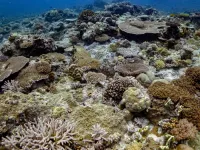(Press-News.org)
Graphics // Video
Traces of sex hormones extracted from a woolly mammoth's tusk provide the first direct evidence that adult males experienced musth, a testosterone-driven episode of heightened aggression against rival males, according to a new University of Michigan-led study.
In male elephants, elevated testosterone during musth was previously recognized from blood and urine tests. Musth battles in extinct relatives of modern elephants have been inferred from skeletal injuries, broken tusk tips and other indirect lines of evidence.
But the new study, scheduled for online publication May 3 in the journal Nature, is the first to show that testosterone levels are recorded in the growth layers of mammoth and elephant tusks.
The U-M researchers and their international colleagues report annually recurring testosterone surges—up to 10 times higher than baseline levels—within a permafrost-preserved woolly mammoth tusk from Siberia. The adult male mammoth lived more than 33,000 years ago.
The testosterone surges seen in the mammoth tusk are consistent with musth-related testosterone peaks the researchers observed in an African bull elephant tusk, according to the study authors. The word "musth" comes from the Hindi and Urdu word for intoxicated.
"Temporal patterns of testosterone preserved in fossil tusks show that, like modern elephants, mature bull mammoths experienced musth," said study lead author Michael Cherney, a research affiliate at the U-M Museum of Paleontology and a research fellow at the U-M Medical School.
The study demonstrates that both modern and ancient tusks hold traces of testosterone and other steroid hormones. These chemical compounds are incorporated into dentin, the mineralized tissue that makes up the interior portion of all teeth (tusks are elongated upper incisor teeth).
"This study establishes dentin as a useful repository for some hormones and sets the stage for further advances in the developing field of paleoendocrinology," Cherney said. "In addition to broad applications in zoology and paleontology, tooth-hormone records could support medical, forensic and archaeological studies."
Hormones are signaling molecules that help regulate physiology and behavior. Testosterone is the main sex hormone in male vertebrates and is part of the steroid group of hormones. It circulates in the bloodstream and accumulates in various tissues.
Scientists have previously analyzed steroid hormones present in human and animal hair, nails, bones and teeth, in both modern and ancient contexts. But the significance and value of such hormone records have been the subject of ongoing scrutiny and debate.
The authors of the new Nature study say their findings should help change that by demonstrating that steroid records in teeth can provide meaningful biological information that sometimes persists for thousands of years.
"Tusks hold particular promise for reconstructing aspects of mammoth life history because they preserve a record of growth in layers of dentin that form throughout an individual's life," said study co-author Daniel Fisher, a curator at the U-M Museum of Paleontology and professor in the Department of Earth and Environmental Sciences.
"Because musth is associated with dramatically elevated testosterone in modern elephants, it provides a starting point for assessing the feasibility of using hormones preserved in tusk growth records to investigate temporal changes in endocrine physiology," said Fisher, who is also a professor in the U-M Department of Ecology and Evolutionary Biology.
For the study, researchers sampled tusks from one adult African bull elephant and two adult woolly mammoths—a male and a female—from Siberia. The samples were obtained in accordance with relevant laws and with appropriate permits.
The researchers used CT scans to identify annual growth increments within the tusks. A tiny drill bit, operated under a microscope and moved across a block of dentin using computer-actuated stepper motors, was used to grind contiguous half-millimeter-wide samples representing approximately monthly intervals of dentin growth.
The powder produced during this milling process was collected and chemically analyzed.
The study required new methods, developed in the laboratory of U-M endocrinologist and study co-author Rich Auchus, to extract steroids from tusk dentin for measurement with a mass spectrometer, an instrument that identifies chemical substances by sorting ions according to their mass and charge.
"We had developed steroid mass spectrometry methods for human blood and saliva samples, and we have used them extensively for clinical research studies. But never in a million years did I imagine that we would be using these techniques to explore 'paleoendocrinology,'" said Auchus, professor of internal medicine and pharmacology at the U-M Medical School.
"We did have to modify the method some, because those tusk powders were the dirtiest samples we ever analyzed. When Mike (Cherney) showed me the data from the elephant tusks, I was flabbergasted. Then we saw the same patterns in the mammoth—wow!"
The African bull elephant is believed to have been 30 to 40 years old when it was killed by a hunter in Botswana in 1963. According to estimates based on growth layers in its tusk, the male woolly mammoth lived to be about 55 years old. Its right tusk was discovered by a diamond-mining company in Siberia in 2007. Radiocarbon dating revealed that the animal lived 33,291 to 38,866 years ago.
The tusk from the female woolly mammoth was discovered on Wrangel Island, which was connected to northeast Siberia in glacial periods of lower sea level but is now separated from it by the Arctic Ocean. Carbon-dating showed an age of 5,597 to 5,885 years before present. (Wrangel Island is the last known place where woolly mammoths survived, until around 4,000 years ago.)
In contrast to the male tusks, testosterone levels from the female woolly mammoth tusk showed little variation over time—as expected—and the average testosterone level was lower than the lowest values in the male mammoth's tusk records.
"With reliable results for some steroids from samples as small as 5 mg of dentin, these methods could be used to investigate records of organisms with smaller teeth, including humans and other hominids," the authors wrote. "Endocrine records in modern and ancient dentin provide a new approach to investigating reproductive ecology, life history, population dynamics, disease, and behavior in modern and prehistoric contexts."
In addition to Cherney, Fisher and Auchus, the authors of the Nature study are Adam Rountrey and Scott Beld of the U-M Museum of Paleontology; Perrin Selcer of the U-M Department of History and the Program in the Environment; Ethan Shirley of the U-M Museum of Paleontology and the Department of Earth and Environmental Sciences; Bernard Buigues of Mammuthus, France; Dick Mol of the Natural History Museum in Rotterdam, Netherlands; Gennady Boeskorov of the Siberian Branch of the Russian Academy of Sciences; Sergey Vartanyan of the Far-East Branch of the Russian Academy of Sciences; and Alexei Tikhonov of the Russian Academy of Sciences and North-Eastern Federal University in Yakutsk, Russia.
Tusk specimens were CT scanned using laboratories at the U-M School of Dentistry, Ford Motor Co., U-M Department of Earth and Environmental Sciences, and U-M Orthopaedic Research Laboratories. The study received support from U-M's seed funding program for innovative interdepartmental collaborations, Mcubed 3.0.
"This is one of the reasons we come to work every morning at the University of Michigan: to make discoveries that empower us to see the world in new ways," co-author Selcer said. "The project shows you the importance of both collaboration across schools—thanks to Mcubed 3.0—and of the university's instrumentation infrastructure."
Study (available once embargo lifts): Testosterone histories from tusks reveal woolly mammoth musth episodes (DOI 10.1038/s41586-023-06020-9)
END
New tusk-analysis techniques reveal surging testosterone in male woolly mammoths
2023-05-03
ELSE PRESS RELEASES FROM THIS DATE:
Evaluation of Waning of SARS-CoV-2 Vaccine–Induced Immunity
2023-05-03
About The Study: The findings of this systematic review and meta-analysis of secondary data from 40 studies suggest that the effectiveness of COVID-19 vaccines against laboratory-confirmed Omicron or Delta infection and symptomatic disease rapidly wanes over time after the primary vaccination cycle and booster dose. These results can inform the design of appropriate targets and timing for future vaccination programs.
Authors: Piero Poletti, Ph.D., of the Bruno Kessler Foundation in Trento, Italy, is the corresponding author.
To access the embargoed study: Visit our For The Media website at this ...
Researchers capture elusive missing step in the final act of photosynthesis
2023-05-03
Menlo Park, Calif. – Photosynthesis plays a crucial role in shaping and sustaining life on Earth, yet many aspects of the process remain a mystery. One such mystery is how Photosystem II, a protein complex in plants, algae and cyanobacteria, harvests energy from sunlight and uses it to split water, producing the oxygen we breathe. Now researchers from the Department of Energy’s Lawrence Berkeley National Laboratory and SLAC National Accelerator Laboratory, together with collaborators from Uppsala University and Humboldt University and other institutions have succeeded in cracking a key secret of Photosystem II.
Using SLAC’s Linac Coherent Light ...
Association between depression and physical conditions requiring hospitalization
2023-05-03
About The Study: In this study that included 240,000 individuals, the most common causes of hospitalization in people with depression were endocrine, musculoskeletal, and vascular diseases, not psychiatric disorders. These findings suggest that depression should be considered as a target for the prevention of physical and mental disease.
Authors: Philipp Frank, Ph.D., of University College London, is the corresponding author.
To access the embargoed study: Visit our For The Media website at this link https://media.jamanetwork.com/
(10.1001/jamapsychiatry.2023.0777)
Editor’s ...
Astronomers witness star devouring planet: possible preview of the ultimate fate of Earth
2023-05-03
By studying countless stars at various stages of their evolution, astronomers have been able to piece together an understanding of the life cycle of stars and how they interact with their surrounding planetary systems as they age. This research confirms that when a Sun-like star nears the end of its life, it expands anywhere from 100 to 1000 times its original size, eventually engulfing the system’s inner planets. Such events are estimated to occur only a few times each year across the entire Milky Way. Though past observations have confirmed the aftermath of planetary engulfments [1], ...
Discovery suggests route to safer pain medications
2023-05-03
Strategies to treat pain without triggering dangerous side effects such as euphoria and addiction have proven elusive. For decades, scientists have attempted to develop drugs that selectively activate one type of opioid receptor to treat pain while not activating another type of opioid receptor linked to addiction. Unfortunately, those compounds can cause a different unwanted effect: hallucinations. But a new study led by Washington University School of Medicine in St. Louis has identified a potential route ...
XFELs show the final milliseconds of oxygen formation
2023-05-03
For the first time, scientists have been able to see the crucial final step in the reaction cycle of Photosystem II, during which oxygen is formed. Using serial femtosecond crystallography performed with the XFEL technique, they have managed to obtain more information on the interaction between Photosystem II and the Mn/Ca cluster. This has been shown in a new study by Uppsala University, published in the journal Nature.
The oxygen we breathe is produced by plants, algae and cyanobacteria, which use the energy of sunlight for powering the formation of oxygen. This is done by the Photosystem II enzyme, ...
To boost cancer immunotherapy’s fighting power, look to the gut
2023-05-03
Cancer immunotherapy has transformed the treatment of many types of cancer. Yet, for reasons that remain poorly understood, not all patients get the same benefit from these powerful therapies.
One potent factor in treatment outcome appears to be an individual’s gut microbiota — the trillions of microorganisms that live in the human intestine — according to new research led by investigators at Harvard Medical School and Dana-Farber Cancer Institute.
The study, done in mice and published May 3 in Nature, pinpoints how gut microbes enhance the body’s response to a common type of immunotherapy known as PD-1 checkpoint ...
Minoan eruption survey improves volcanic risk assessments
2023-05-03
Volcanic eruptions are spectacular, violent and dangerous. Large explosive eruptions can even have global impacts. To classify the size of volcanic eruptions, the magma volume and the deposition volume are determined. Volcanologists estimate these values in order to compare the size of different volcanic eruptions or to obtain a measure of the explosiveness of the eruption. However, it is often not possible to determine the values accurately. This makes it difficult to infer the actual volume of magma and to measure the complete extent of such eruptions. In particular, because the deposits of the most violent historical eruptions are partially or completely under water, which makes geological ...
Indo-Pacific corals more resilient to climate change than Atlantic corals
2023-05-03
UNIVERSITY PARK, Pa. — In the face of global warming and other environmental changes, corals in the Atlantic Ocean have declined precipitously in recent years, while corals in the Pacific and Indian Oceans are faring better. By describing several species of symbiotic algae that these corals need to grow, an international team led by Penn State has found that these mutualistic relationships from the Indo-Pacific may be more flexible and ultimately resilient to higher ocean temperatures than those in the Atlantic.
Coral reefs are vast geological structures made of calcium carbonate produced by coral animals whose colonies possess dense populations ...
More woodlands will not impact tourism
2023-05-03
Hiking, cycling, climbing and boating. When we take time off from work or school, we like to go out into nature. The landscape in other words play an important role for our vacations. To promote biodiversity and carbon sequestration there is a focus on planting more trees, especially in upland areas such as Howgill Fells. The Howgill Fells is located in the north-west of England and is known for its soft, rolling and open landscape. It is a popular area for tourists seeking the outdoors and hill-walking in particular. But how ...




